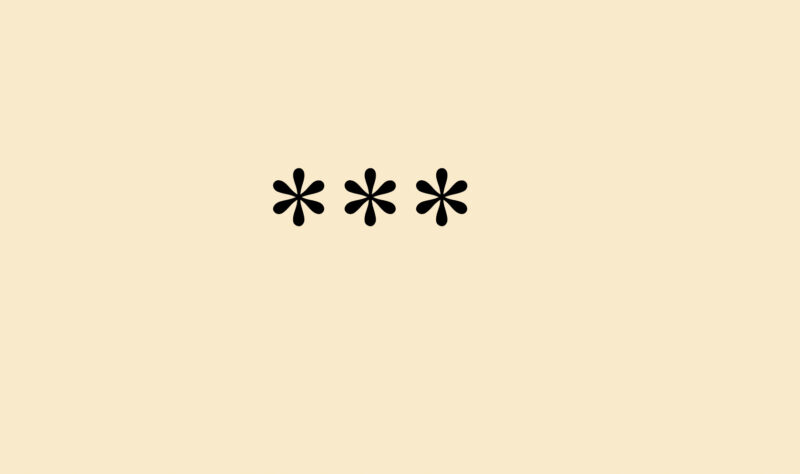 The dinkus. You know, the three asterisks beloved of a certain kind of fiction writer to split the chapter into some kind of sub-chapter. The three asterisks that boldly chop a book into TV scenes, as if watching it on a screen, and… DINKUS! FADE TO BLACK!
The dinkus. You know, the three asterisks beloved of a certain kind of fiction writer to split the chapter into some kind of sub-chapter. The three asterisks that boldly chop a book into TV scenes, as if watching it on a screen, and… DINKUS! FADE TO BLACK!
Here’s why, as a book editor and reader, Cate Baum can’t stand this beloved flowery operator, and why you should stop using it so lavishly in your book.
1. Formatting your book is suddenly a massive pain
When I receive manuscripts to format into paperbacks or eBooks, I cannot do what I would expect to do and simply format the book’s alignment in one swoop if it contains the dinkus. No! I have to go find those pesky dinkuses (dinkii?) and center the mothers after justifying the whole text. Then I have to do what the author hasn’t done and should have, which is to put white space above and below the thing and then un-indent the next paragraph. I find them everywhere, no rhyme or reason to them once they appear. They breed, it seems, once the author has them in mind, like gremlins.
Newsflash: The first chapter paragraph AND the first dinkus paragraph (that’s what I’m calling it) should not be indented! So why do 99% of all authors think they should be? This is dinkus thinking gone wild.
2. A cast of thousands rears up
How many character POVs do we really need? Sometimes, this dinkus business gives the writer more than ten POVs in one book! The problem with the dinkus is that it encourages this adding of POVs, often used in all the TV shows we watch when relaxing. This affects how we write. Think about how crazy this would be in a TV show if you had ten protagonists, all equally important.
It was hard enough to keep up with LOST‘s cast of thousands, and do you remember that awful season of The Walking Dead when every extra seemed to have a back story and a monologue with a gun? Yeah. You know what the writers had to do to them in the end…heads on pikes, people. Heads on pikes.
3. Your book’s flow is lost to the dinkus
If I wanted to be chopped into flashy pieces by a book, I’d be watching a soap instead. A book’s plot needs to flow, arc, vehicle…you’ve heard all these terms. They mean something. The dinkus gives us as the garage sale tchotchkes you lined up on your book’s sideboard and kept for sentimental reasons when you should have thrown them out of your book’s development ages ago. Have you seen Hoarders? Now we’re reading eighteen scenes about mothers or girlfriends making food and teas in great detail, thinking on things we just saw in action. Dinkus work, I say. Your plot needs to keep moving.
Writer Brandon Taylor says in his essay, ‘I Reject Your Asterisks, and Your Dinkus, Too’ (2018), via Literary Hub, “You do not need to mark all transitions with asterisks simply because you have more than one transition. Do not infantilize your readers and afflict them with hideous typography.”
4. The dinkus kills chapter goals
If a scene shifts a short jump in time, or to a new thought that requires a new setup, consider this: Does this still fit with the theme of this chapter? If you don’t know the answer to that question, don’t make the mistake of many other authors and say, “To heck with it! Throw in a dinkus!” No. This means you did not plan what each chapter is about. What is this chapter for? Does it propel the story? For instance, in Chapter One, we introduce the characters. Chapter Two, introduce the dilemma, etc. Never write a chapter without knowing its goal first.
It works the other way too. I cannot tell you the number of books I have edited that use a dinkus when a new chapter is needed. Here’s the thing: If a scene changes to a different place, with either a new character or a different time, you need a new chapter and NOT a dinkus! if a character simply goes on somewhere from where they are now in the same time and space, you only need a new paragraph, NOT a dinkus.
5. The dinkus is an indication of chaos
So following on from that, let’s remember this is a book, not a visual scene on a screen, so you can jump between scenes and characters quite naturally by simply using a new paragraph. You don’t need to fade out or jump cut. By organizing your book before you write it, you can ensure that each chapter has a purpose and a theme, and moves along logically.
Merging sections in your book will not be the solution, but many sections can probably lose the dinkus if you organize your story. You shouldn’t need a dinkus at all if you have really thought out your book’s structure.
When a dinkus is needed in fiction
A man sits on a hill thinking about killing someone who murdered his wife twenty years back in London. Then he thinks about when he found his wife’s body that day.
*** DINKUS!
He finds his wife’s body, twenty years ago, in London.
In other words, the dinkus should be used to denote a shift in time or scene but ONLY within the theme of the scene we have just read, or else you need a new chapter. Mostly, after the dinkus is used in this way, it will feel like the end of a chapter. So it should be.
Here’s to dinkus-free writing goals to make your prose better!
Get an Editorial Review | Get Amazon Sales & Reviews | Get Edited | Get Beta Readers | Enter the SPR Book Awards | Other Marketing Services






















Leave A Comment